| Article ID | Journal | Published Year | Pages | File Type |
|---|---|---|---|---|
| 6397308 | Food Research International | 2013 | 11 Pages |
Abstract
The jellyfish belonging to the Rhizostomeae order are a typical Asian seafood and are nowadays also marketed in the Western countries. The jellyfish species used for food cannot be identified due to the loss of the morphological characteristics during processing. In this work, a pre-extraction treatment consisting of desalting under running water for 48Â h, followed by incubation in 400Â mM EDTA solution for 1Â h, was developed for products containing high concentration of salts. Moreover, considering the DNA degradation observed in both classical (CPs) and ready to eat (RE) commercial samples, five sets of primers for the amplification of fragments with different lengths belonging to the mitochondrial COI gene were designed and used to obtain the sequences from 54 reference specimens and 70 market samples. A phylogenetic analysis was then performed using the neighbor-joining method. It was found that a fragment of 142Â bp was enough informative to allow identification at the species level. The results showed that most of the products were made of Nemopilema nomurai (94% of RE and 45.5% of CPs). The analysis permitted to uncover an alarming level of mislabeling which reaches 79% for CPs and 100% for ready-to-eat products.
Related Topics
Life Sciences
Agricultural and Biological Sciences
Food Science
Authors
Andrea Armani, Lara Tinacci, Alice Giusti, Lorenzo Castigliego, Daniela Gianfaldoni, Alessandra Guidi,
